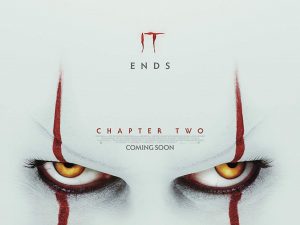TRANSLATING Stephen King’s iconic works to the screen has always been a challenge.
After the failure of The Dark Tower in 2017, producers have avoided the tougher material in favour of King’s lower-hanging fruit.
So we’ve had a recent plethora of adaptations, largely to the smaller screen with Netflix one of the main plunderers.
The results have been generally decent and entertaining watches, if a little slight in themes and overall impact.
Back on the big screen, in 2017 the creative team of Andy Muschietti and Gary Dauberman also had a crack at one of the older mega-novels, IT, and the result was well received.
It wasn’t a great film but managed to capture both King’s nostalgic and nightmarish sensibilities, pitting a bunch of classically portrayed kids against an evil, murderous clown.
The casting was spot-on with great chemistry between the young teenagers and a truly disturbing turn from Bill Skarsgard as Pennywise.
IT had been previously made as a television mini-series in the 1980s and was good fun but hampered by poor special effects.
What I did like about the mini-series was the successful juggling of events from two time periods: 1989, when the young group first realised their home town was being periodically terrorised by Pennywise, and 2016 when the group returned as adults to battle Pennywise once again.
In contrast, the 2017 cinema version chose to only tell the first part of the story set in 1989 and ended with the group, who called themselves The Losers Club, swearing a blood oath to return if they are ever needed again.
IT: Chapter Two is the story of that return to Derry, Maine, and, once again, it’s entertaining and occasionally a little frightening, bolstered by strong acting and a much bigger and better visual effects budget.
But the decision to split the story across two films creates a problem with the narrative structure that impacts on the running time, pacing and overall tension of Chapter Two.
There are seven principle characters and because Chapter One restricted itself to the young versions it was able to divide its running time appropriately.
But Chapter Two has to deal with the story as adults plus key flashbacks that enhance the later events plus manage the fact that it’s been two years since the last film and some viewers need to be reminded who is meant to be who.
You could argue that Chapter Two stands by itself as a story, but if that’s true – and I have my doubts – it’s mainly due to the almost three-hour running time.
That’s a long time for a horror movie, even if it is encapsulated within a coming-of-age story.
There’s another problem because what works as individual chapters for each character becomes a little repetitive on screen, especially when you are also repeating some of the events from the previous film.
So, after all that, what are the highlights of Chapter Two?
The opening attack sequence is strong, even though it doesn’t relate much to the main characters, and the reunion at a Chinese restaurant is a nice balance of comic horror.
While the climax in the sewers is impressive, the stand-out sequences are in the old house just prior to this, Richie confronting Pennywise in a hall of mirrors and when Beverly visits an old lady.
Muschetti is again directing and co-writing along with Gary Dauberman who has also written three Annabelle films and The Nun.
The best decisions they make are not to significantly alter King’s original story and in their casting choices, led by Jessica Chastain as Beverly, James McAvoy as Bill, Bill Hader as Richie and Bill Skarsgard as Pennywise.
While it makes the film slower and baggier it’s still good to have the excellent young cast from Chapter One back for new flashbacks.
Chapter Two is fun, but seriously lags at times. I would have rather had one three-hour movie that covered everything.
